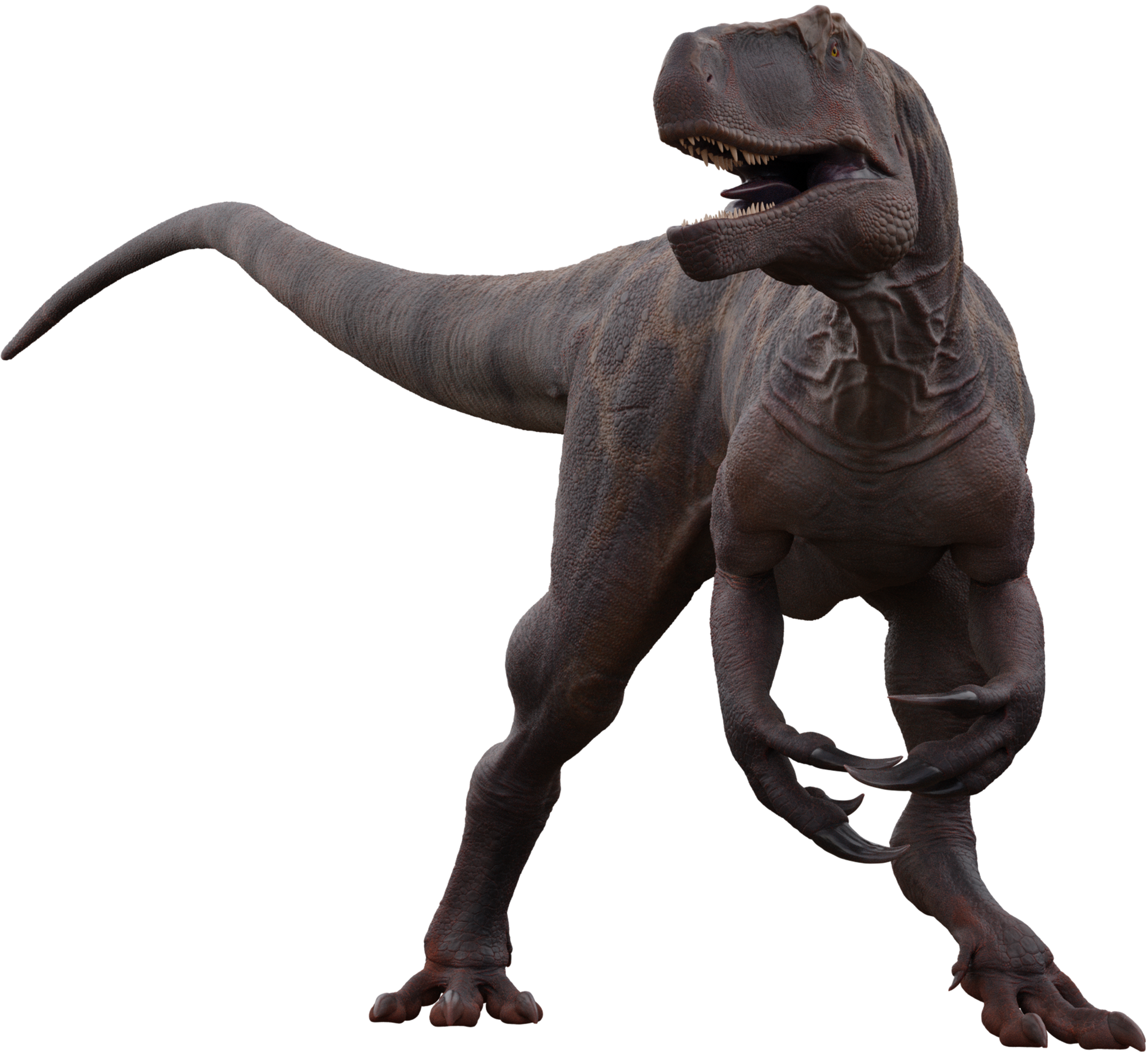The Mysterious Mesopredator of the Morrison
This medium-sized megalosauroid was one of the rarer predators of the Morrison and we still know very little about it to this day.
Overview: The Late Jurassic Morrison Formation of the western USA is known for its huge assemblage of sauropods and theropods. One of these theropods was Marshosaurus, a piatnitzkysaurid megalosauroid discovered in Utah in the mid-20th Century and named by James "Jim" Madsen. Unlike coeval theropods like Allosaurus, Marshosaurus was much smaller and comparatively rare, leaving many details of this Morrison mesopredator a mystery. Interestingly, its size and its rarity may actually be related, as mesopredator theropods tend to be rare or absent in environments with large theropods, and there was certainly no shortage of large theropods in the Morrison ecosystem Marshosaurus called home.
Discovery: Marshosaurus bicentesimus was discovered in the 1960s in the Cleveland-Lloyd Quarry near Price, Utah, USA, which yielded over 14,000 dinosaur bones from the Late Jurassic Morison Formation. Among these bones were the Marshosaurus holotype (original specimen) and three paratypes (specimens that are not the name-bearing holotype, but which were used to help define a species). The holotype (UMNH VP 6373) consists only of a left illium, the upper part of the pelvis. The paratypes (UMNH VP 6379, UMNH VP 380, UMNH VP 6387) were also from the pelvis, two ischia and a pubis. Some additional incomplete material from Cleveland-Lloyd, including three illia and six jaw fragments, were also referred to Marshosaurus. The animal was named in 1976 by the great Allosaurus expert James “Jim” Madsen, who would later have a new species of Allosaurus named after him (Allosaurus jimmadseni) in 2020. Its name means “Marsh’s Lizard” after Othniel Charles Marsh of Bone Wars fame who discovered many well-known Jurassic Dinosaurs, including Allosaurus. The species name bicentesimus was given to honor the bicentennial of the United States of America. Since then, possible additional specimens of Marshosaurus have been discovered in Dinosaur National Monument, Utah, and in the Dry Mesa Quarry near Delta, Colorado.
Evolution: Marshosaurus is thought to belong to the family Piatnitzkysauridae, which also included the larger Argentine Piatnitzkysaurus. Piatnitzkysaurids were in turn members of the Megalosauroidea, the group which also includes the European Megalosaurus (the first dinosaur scientifically named) and the large Morrison Torvosaurus, as well as the famous spinosaurids. Megalosaurs were the dominant land predators during the Middle Jurassic, and continued into the Late Jurassic, though with stronger competition from allosaurs. More recently, a study has suggested that the megalosauroids may be paraphyletic, and actually represent a grade of carnosaurian theropods leading up to allosauroids. Megalosaurs had the standard large theropod body plan; bipedal with big heads and reduced arms. Megalosaurs generally had somewhat longer and lower skulls than allosaurs, with powerful jaws, and large hook-like claws on their hands.
Description and Ecology: Little is known about how specifically Marshosaurus looked, but it probably looked similar to other megalosaurs, described previously. Its skull was probably about 0.6 m (2 ft) long, and its total body length was likely around 4.5 meters (15 ft). It probably weighed around 200 kilograms (440 lb). This is “medium” by theropod standards, and probably meant it was a mesopredator, the niche between small predators and apex predators. And there was no shortage of Prey in the Morrison. Sauropods, the dominant Morrison herbivores, included Camarasaurus, Brachiosaurus, Haplocanthosaurus, Barosaurus, Diplodocus, Apatosaurus, and Supersaurus. Ornithischians (“bird-hipped” dinosaurs) included Stegosaurus, Camptosaurus, Dryosaurus, and Nanosaurus. Early mammals, all very small, were also present. Marshosaurus was probably too large to catch small mammals, but probably too small to hunt things like Camptosaurus, Stegosaurus, or any of the sauropods. Instead, it may have gone after small-mid range prey like Nanosaurus and Dryosaurus, or the juveniles of larger species.
Marshosaurus shared its hunting grounds with several other carnivores. The smaller Ornitholestes likely wouldn’t have posed much of a threat or a source of competition. The early tyrannosauroid Stokesosaurus was only slightly smaller than Marshosaurus and may have competed for similar prey. Larger predators included Ceratosaurus, Allosaurus, and Torvosaurus. Of these, Torvosaurus was the largest, over twice the length of Marshosaurus, but Allosaurus was by far the most common. Any of these larger theropods could have competed with Marshosaurus for food where their preferred prey size overlapped, and the larger predators could have also acted as kleptoparasites, using their larger size to “bully” the smaller theropod and steal its kills. What’s more, even if Marshosaurus and the larger Morrison theropods had very little prey overlap, Marshosaurus would have had stiff competition from the juveniles and subadults of these larger carnivores, which would have occupied different niches than the adults, and competed with Marshosaurus in the role of mesopredator. This might explain the comparative rarity of Marshosaurus, as well as the comparative rarity, or outright absence, of theropod mesopredators in other “megatheropod”-dominated ecosystems throughout the Mesozoic.
Extinction and Legacy: Marshosaurus lived about 155-152 million years, making it one of the last known megalosaurs, along with the coeval Torvosaurus, besides the spinosaurids which lasted through the Early Cretaceous. This was likely in part due to competition from allosaurs. Just in the Morrison, Allosaurus made up some 70-75% of all theropods. And worldwide, allosauroids were replacing or had already replaced the megalosauroids as the apex terrestrial predators. Beyond this, Marshosaurus may have simply experienced too much competition from the juveniles and subadults of Allosaurus, Ceratosaurus, and fellow megalosaur Torvosaurus, and so was driven to extinction. Perhaps there just wasn’t room for another mesopredator when the niche was being filled by the young of so many other theropod species. In any case, by the end of the Jurassic, Marshosaurus was gone. The bones of Marshosaurus are housed in the Natural History Museum of Utah, in Salt Lake City, UT, USA, where there is also a Marshosaurus reconstruction on display.
Marshosaurus FAQ
Marshosaurus size / How big was Marshosaurus?
See height, weight, and length.
Marshosaurus height / How tall was Marshosaurus?
Marshosaurus was probably around 1.6 meters (5.25 ft) tall.
Marshosaurus weight / How much did Marshosaurus weigh?
Marshosaurus probably weighed about 200 kilograms (440 lbs).
How long was Marshosaurus?
Marshosaurus was about 4.5 meters (15 ft) long.
What did Marshosaurus eat?
Marshosaurus ate meat, probably small to medium sized dinosaurs.
What is Marshosaurus’s closest living relative?
Like all dinosaurs, the closest relatives of Marshosaurus are the only surviving lineage of dinosaurs today, the birds. Crocodilians, while not dinosaurs themselves, are also more distant cousins of dinosaurs.
Marshosaurus family members / Marshosaurus family / What kind of dinosaur was Marshosaurus?
Marshosaurus was a theropod (two-legged, mainly carnivorous dinosaurs) in the family Piatnitzkysauridae, which may be related to either the megalosaurs (like Megalosaurus and Torvosaurus) or to the allosauroids (like Allosaurus).
Where did Marshosaurus live? / Where was Marshosaurus found?
Marshosaurus lived in western North America and has been found in Utah and possibly Colorado.
When did Marshosaurus live?
Marshosaurus lived about 155-152 million years ago in the Late Jurassic Period.
What does Marshosaurus mean? / Marshosaurus name meaning
Marshosaurus means “Marsh’s Lizard”, named after famous 19th Century paleontologist Othniel Charles Marsh.

